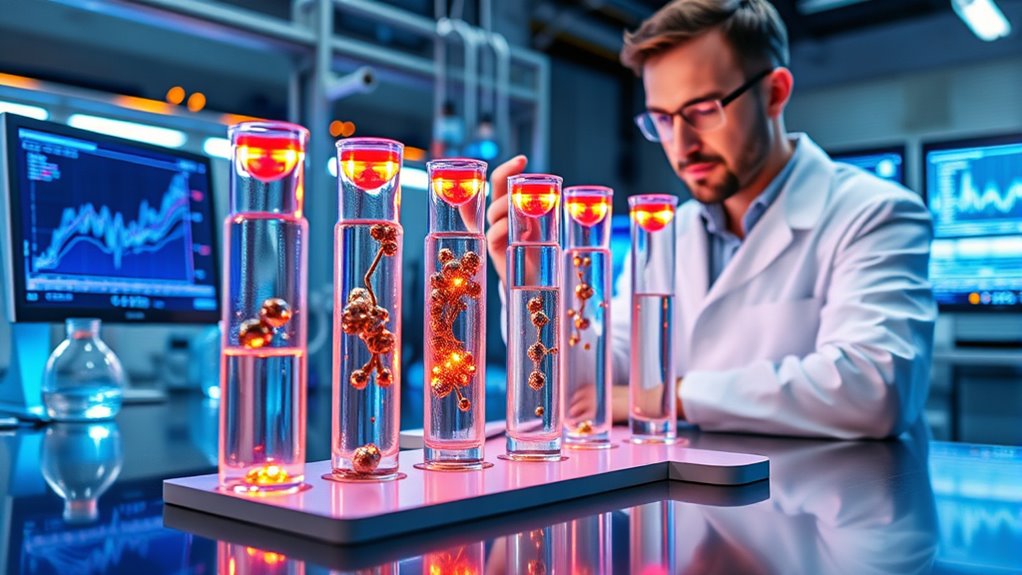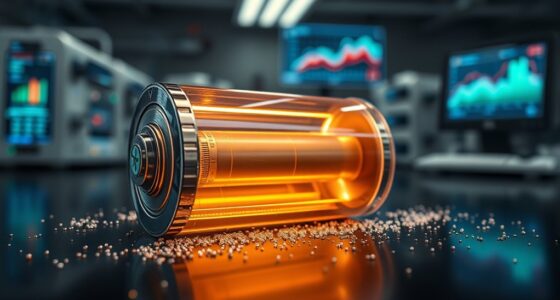Recent research highlights breakthroughs in catalyst design that boost efficiency and stability, such as liquid metal catalysts and single-atom structures. Innovations in nanostructured porous materials, microreactors, and nanoparticle stabilization help accelerate reactions and reduce costs. Electrocatalysts now last longer for renewable energy applications, while AI-driven discovery and advanced spectroscopy uncover reaction mechanisms. These advances are transforming industries toward greener, more efficient processes, and exploring these trends reveals more exciting developments ahead.
Key Takeaways
- Advances in liquid metal catalysts enable low-temperature, energy-efficient organic conversions with self-regenerating stability.
- Real-time in-situ spectroscopy reveals catalyst phase cycles, optimizing reaction pathways and improving efficiency.
- Development of nanostructured and porous materials enhances active-site density and reactant diffusion for higher turnover frequencies.
- Integration of AI accelerates catalyst discovery, mechanism understanding, and process optimization for sustainable reactions.
- Novel catalyst designs for green energy applications, such as CO₂ conversion and water splitting, significantly boost reaction efficiency.
Advances in Catalyst Types and Their Industrial Applications
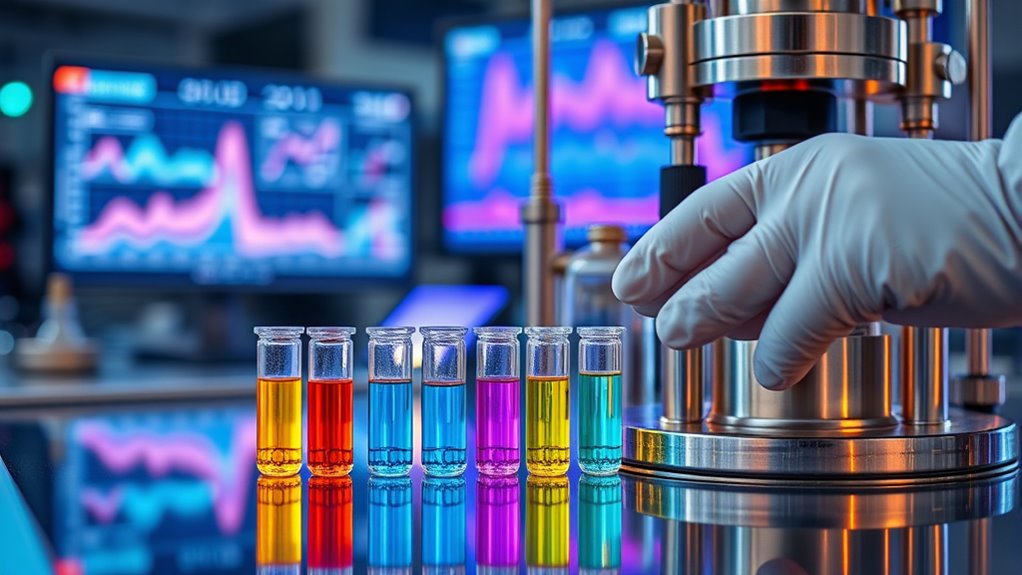
Have you ever wondered how recent innovations in catalysts are transforming industrial processes? Liquid metal catalysts, like gallium-based systems, dissolve metals such as nickel and tin, enabling low-temperature C-H activation and organic conversions. They consume less energy because they self-regenerate and stay stable under reaction conditions, minimizing by-products through unique pathways compared to solid catalysts. These systems have proven scalability in hydrocarbon processing and petrochemicals and are increasingly adopted in green chemistry due to reduced thermal input needs. Tungsten oxide innovations improve photocatalytic efficiency for solar fuels and pollutant breakdown, with high thermal stability allowing operation in tough industrial environments. Meanwhile, single-atom catalysts maximize active sites, boosting efficiency in fuel synthesis and emissions reduction, revolutionizing how industries approach catalysis. Catalyst Types, Roles, and Mechanisms of Interconversion also reveal that understanding the cyclic transformation between molecular and surface catalyst forms can lead to more effective catalyst designs.
Insights From Recent Studies on Catalyst Cycling and Form Transitions
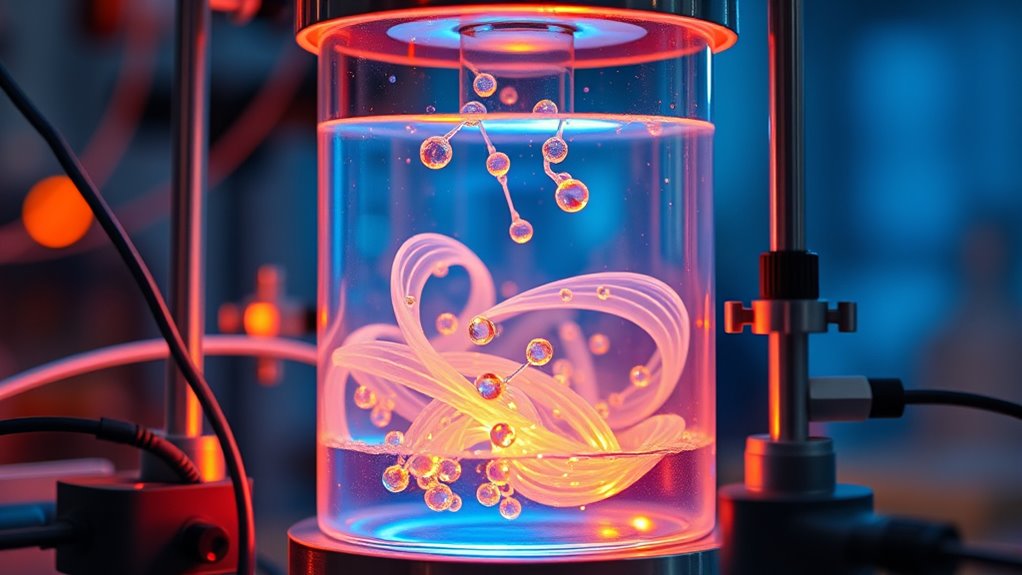
Recent studies have revealed that catalyst behavior is more dynamic than traditionally assumed, especially in processes like vinyl acetate synthesis. You’ll find that catalysts don’t stay fixed in a single form; instead, they cycle between solid surface states and dissolved molecules. This interplay challenges the old notion of static catalyst stability and highlights the importance of phase changes for reaction efficiency. Advanced analytical techniques, like in-situ spectroscopy, provide direct evidence of these cycles, enabling real-time monitoring of catalyst behavior. Recognizing this dynamic nature means you should rethink catalyst design—considering dual-phase behavior and optimizing transition frequencies. AI-driven research is accelerating the discovery of mechanisms behind these phase changes. Embracing this knowledge can reduce catalyst waste, lower energy use, and improve yields. These insights open new avenues for developing more durable, efficient catalysts that adapt during reactions, revolutionizing process optimization.
Innovations in Electrocatalysis and Catalyst Longevity
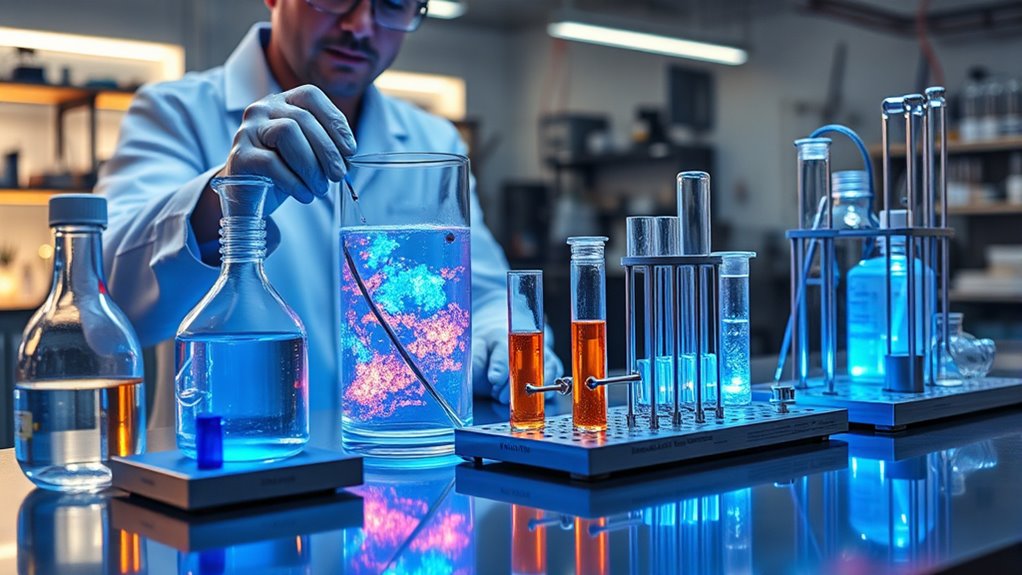
Advancements in electrocatalysis are transforming sustainable energy technologies by enhancing catalyst performance and durability. Automation plays a key role, increasing experiment speed, precision, and reproducibility, which accelerates discovering new catalysts. Recent research uncovers catalysts can change forms unexpectedly during reactions like nitrate reduction, impacting stability. Operando microscopy and spectroscopy reveal how catalyst structures evolve, guiding the design of more durable materials. Developing novel catalysts for hydrogen oxidation and oxygen reduction improves reaction kinetics, reducing costs and extending fuel cell lifespans. Innovations in materials and understanding of composition changes support the creation of longer-lasting electrocatalysts. These advances boost efficiency in green hydrogen production, fuel cells, and energy storage, directly contributing to global sustainability efforts by making clean energy technologies more reliable and economically viable. Automation enhances data handling and process standardization, further supporting the development of durable catalysts.
The Role of Porous Materials and Nature-Inspired Structures in Boosting Efficiency
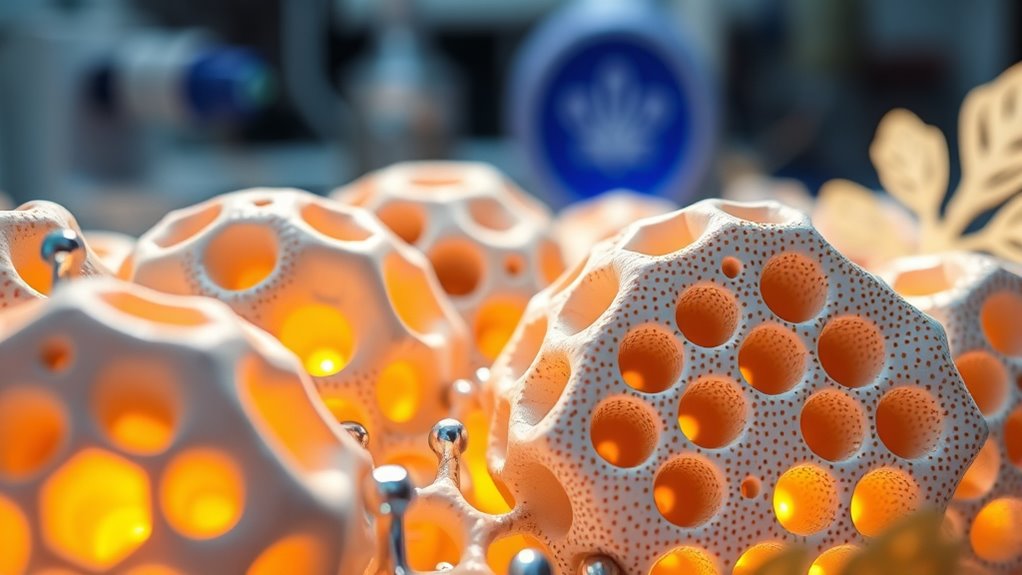
Porous materials and nature-inspired structures are revolutionizing catalytic processes by enhancing reaction efficiency and resource utilization. You benefit from porous thin-film microfluidic systems that achieve TOFs over 4000 h⁻¹ by improving reactant diffusion and immobilizing catalysts effectively. These films optimize physical space, increasing active site density and boosting throughput, with potential expansion into gas-phase reactions for broader industrial use. Mesoporous spinel catalysts deliver high atomic efficiency for energy applications like water splitting and CO₂ conversion, maintaining stability under harsh conditions. Porous liquids, such as COF-301-PL, enable efficient CO₂ capture and catalysis, reducing energy costs and streamlining separation. Microreactor designs with engineered pore architectures provide precise control over reactant contact times, facilitating real-time process optimization and scalable catalyst screening.
Enhancing Reaction Rates Through Nanoparticle Stabilization and Embedding
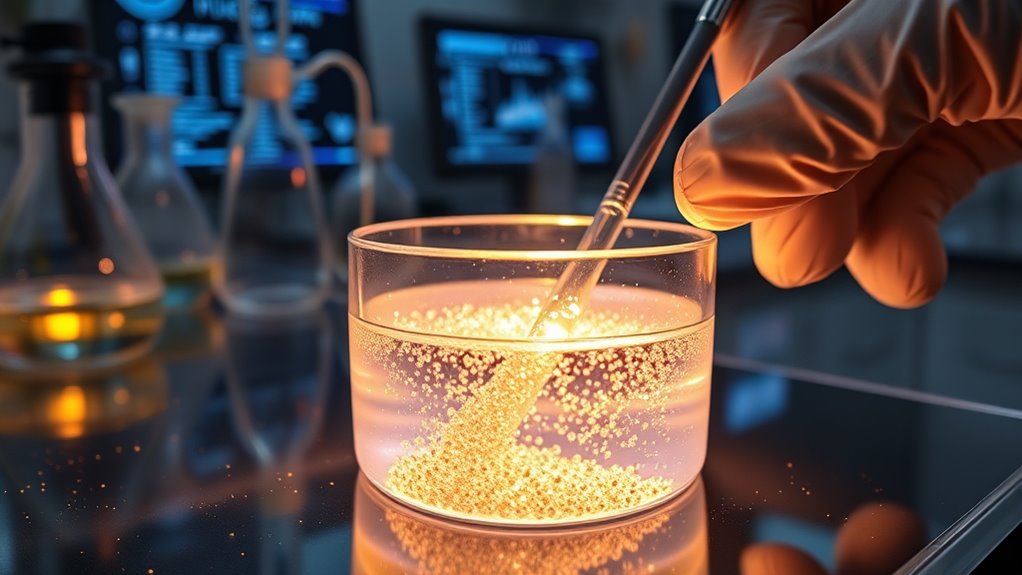
Enhancing reaction rates often depends on increasing the availability of active catalytic sites, which can be achieved by stabilizing and embedding nanoparticles. Smaller nanoparticles offer a larger surface area per unit mass, providing more active sites for catalysis. Stabilizers like PVP, dendrimers, and block copolymers prevent aggregation, preserving surface area and active facets essential for efficiency. Embedding nanoparticles into enzyme complexes or nanostructures improves substrate accessibility and enzyme stability, boosting catalytic performance. Techniques such as RAFT polymerization create stable single-chain nanoparticles, while nanoparticles also act as radical trappers, enhancing oxidative stability. By maintaining nanoparticle dispersion and structure, you maximize catalytic activity and reaction rates, ensuring the catalyst remains effective over time and under varying conditions.
Microfluidic and Thin-Film Catalysts for Improved Diffusion Control

Nanoparticle stabilization and embedding techniques have markedly improved catalytic efficiency by increasing active surface areas and preventing aggregation. Microfluidic configurations allow you to precisely control fluid flow, boosting diffusion control and reaction rates. Thin-film catalysts, especially porous metal-organic frameworks (MOFs) and covalent organic frameworks (COFs), maximize surface interactions and enable repeated catalytic cycles, raising turnover frequencies beyond 4000 h⁻¹. Microfluidic designs with cross-flow and programmed diffusion lengths optimize reactant residence times, enhancing both speed and selectivity. Porous thin films facilitate better reactant diffusion and chemical functionality. Continuous flow operations and chaotic advection improve mixing and overall efficiency. Controlling diffusion processes is essential for optimizing catalytic performance, making the system adaptable, scalable, and flexible, allowing you to fine-tune reactions for better resource utilization and higher yields.
Cutting-Edge Designs for Optimized Catalyst Distribution and Stability

Advances in catalyst design now focus on precisely controlling distribution and guaranteeing long-term stability, which are critical for sustainable and efficient reactions. You’ll find that nanoconfined morphologies, like stacked nanosheets, boost selectivity and reaction kinetics by trapping intermediates and optimizing local reactant concentrations. Inverse catalysts, such as ZrO₂/Cu structures, provide high interfacial contact, eliminating unwanted CO formation and enhancing stability. Support modifications, like homogeneous ZrAl, improve dispersion and reducibility, extending catalyst lifetimes. Advanced synthesis techniques, including oxalate sol-gel co-precipitation and nanofragment deposition, ensure high active-site density and thermal stability. Morphological confinement stabilizes intermediates, reduces deactivation, and maintains performance over time. These designs effectively enhance catalyst distribution, prevent sintering, and promote durable, high-efficiency reactions.
Practical Applications: From Pharmaceuticals to Environmental Sustainability
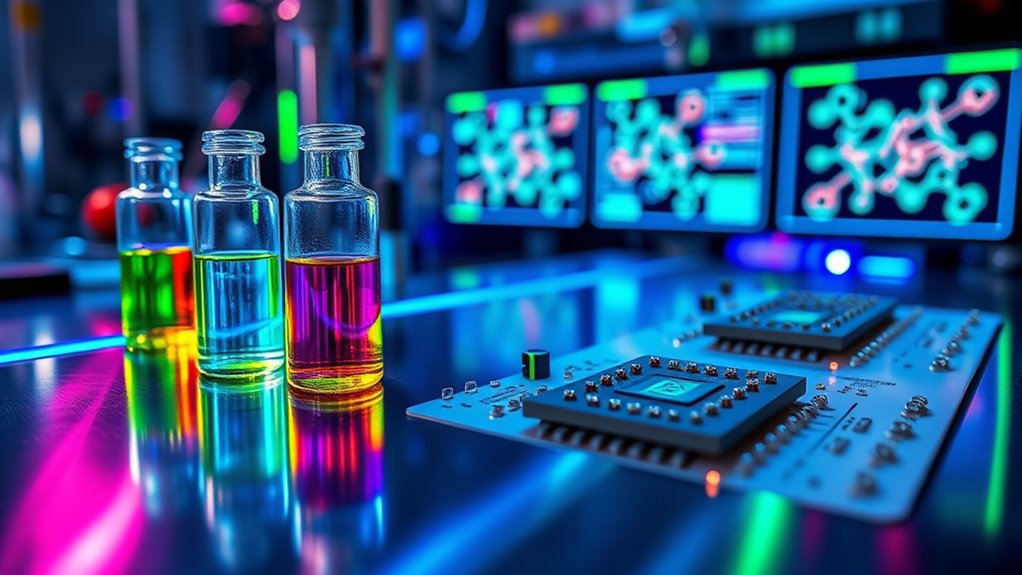
Catalysis plays an essential role across various practical fields, especially in pharmaceuticals and environmental sustainability. In pharmaceuticals, catalysts enhance drug synthesis by reducing steps and boosting purity, all while aligning with green chemistry principles that minimize waste. Shift metals like palladium and rhodium enable complex reactions, and catalyst recycling helps cut costs and environmental impact. Biocatalysts, such as enzymes, offer high selectivity for delicate reactions. In environmental sustainability, catalysis reduces emissions, treats pollutants, and lowers energy use by operating at milder conditions. Catalytic technologies also aid greenhouse gas capture and promote sustainable materials like bioplastics. Overall, catalysis drives more efficient, eco-friendly solutions across industries, helping you develop cleaner processes and contribute to a healthier planet.
Future Directions in Catalyst Development and Sustainable Technologies
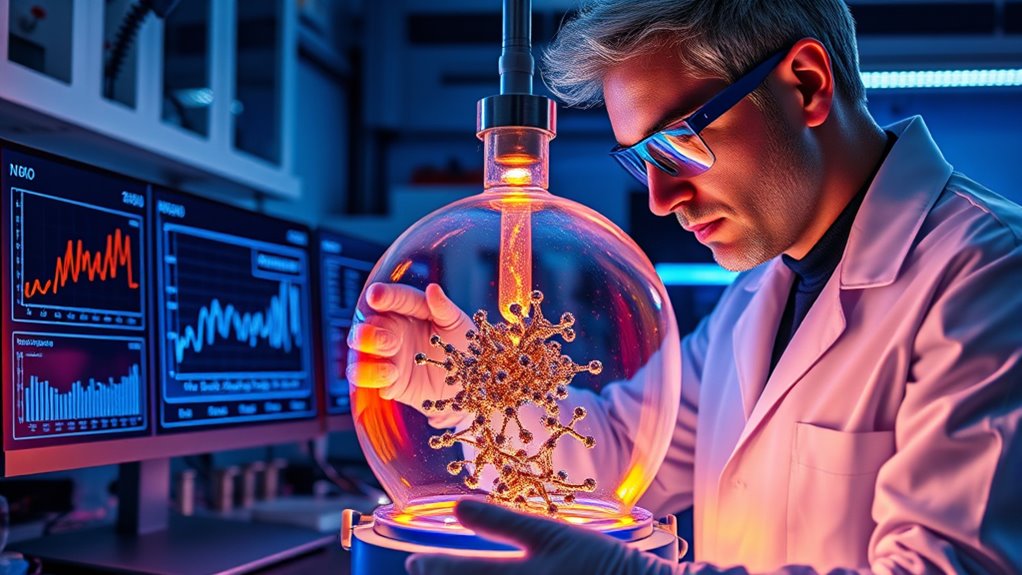
Emerging trends in catalyst development are shaping a more sustainable and efficient chemical industry. You’ll see bio-based catalysts gaining popularity, reducing dependence on finite resources, while nano-catalysts boost reaction rates through larger surface areas. Zeolite catalysts are being fine-tuned for cleaner hydrocarbon cracking, meeting stricter emission standards. Recyclable systems minimize waste, and metal-organic frameworks allow precise control over active sites, enhancing selectivity. In the low-carbon economy, electrocatalysts improve green hydrogen production, and carbon capture catalysts convert CO₂ into useful fuels. Hydrogenation catalysts support renewable energy storage, and fuel cell catalysts reduce platinum needs. Advancements in AI, in-situ spectroscopy, and flow chemistry accelerate catalyst discovery and process optimization. Stricter regulations and circular economy policies push for cleaner, regenerable catalysts, shaping a sustainable future.
Frequently Asked Questions
How Do Catalyst Cycling Mechanisms Influence Overall Reaction Efficiency?
You see, catalyst cycling mechanisms directly impact reaction efficiency by enabling faster, smoother reactions. When catalysts oscillate between different states or switch energy surfaces, they lower activation barriers and provide alternative pathways. This dynamic behavior helps in maintaining high turnover rates, optimizing surface interactions like adsorption and desorption, and preventing catalyst poisoning. By controlling these cycles, you can substantially enhance the overall speed and energy efficiency of chemical processes.
What Are the Practical Challenges in Embedding Nanoparticles Into Substrates?
When embedding nanoparticles into substrates, you face practical challenges like ensuring uniform dispersion, preventing agglomeration, and achieving strong adhesion. Variations in pH, ionic strength, and surface chemistry can cause clustering or detachment. You also need to match thermal expansion properties and avoid structural damage during operation. Additionally, maintaining scalability while controlling costs and meeting regulatory standards adds complexity, making the embedding process a delicate balance between performance and practicality.
How Do Porous Materials Mimic Natural Structures to Enhance Catalysis?
Imagine a spider weaving its web, creating a complex, reticular network that captures prey efficiently. Porous materials mimic this natural design by forming intricate, interconnected structures that boost catalytic activity. They provide large surface areas, facilitate reactant access, and create microenvironments that improve selectivity. This natural mimicry enhances reactions, like CO2 conversion, by optimizing conditions and increasing the exposure of active sites, just like a web captures more insects.
What Are the Cost Implications of Adopting Advanced Catalyst Designs?
When you adopt advanced catalyst designs, you face higher R&D costs due to specialized equipment, longer development times, and integration of AI and computational modeling. However, these investments can pay off through lower operational expenses, improved reaction control, higher product purity, and longer catalyst lifespan. You’ll also benefit from reduced waste and regulatory costs, making advanced catalysts a strategic choice for long-term efficiency despite the initial outlay.
How Can Future Research Balance Catalyst Performance With Environmental Sustainability?
Balancing catalyst performance with environmental sustainability is like walking a tightrope—you need precision and balance. You should focus on designing recyclable, stable catalysts that boost efficiency while minimizing waste and pollution. Incorporate green technologies like water-based reactions and solar-driven processes, and explore biomimetic or biocatalytic approaches. By aligning innovation with eco-conscious practices, you can guarantee future catalytic advancements serve both industry needs and the planet’s health.
Conclusion
As you explore these breakthroughs, remember that each innovation fuels the engine of progress, transforming challenges into opportunities. Like a spark igniting a flame, recent advances in catalysis light the way toward a more sustainable future. By embracing these cutting-edge developments, you’re not just witnessing change—you’re part of a movement that turns scientific dreams into reality, shaping a cleaner, more efficient world where science and innovation dance in harmony.
